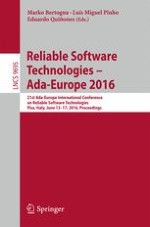2016 | Buch
Reliable Software Technologies – Ada-Europe 2016
21st Ada-Europe International Conference on Reliable Software Technologies, Pisa, Italy, June 13-17, 2016, Proceedings
herausgegeben von: Marko Bertogna, Luis Miguel Pinho, Eduardo Quiñones
Verlag: Springer International Publishing
Buchreihe : Lecture Notes in Computer Science
